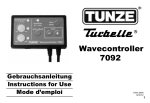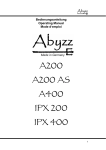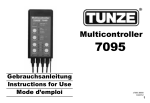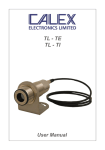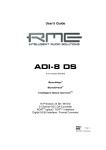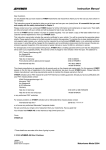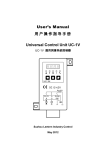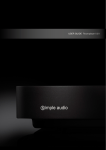Download manual ACS english - The Aquarium Solution
Transcript
User manual Abyzz Control System 1 © 2013 venotec GmbH GmbH Am Nordkreuz 36 26180 Rastede Deutschland www.venotec.de The product specifications may deviate from the information in this manual due to technical improvements and innovations. Abyzz and venotec are registered trademarks. Valid as of: 25.10.13 2 Table of content Page Table of content 3 Table of figures 4 Preface 5 Scope of delivery 6 Function description 7 Warnings 8 Installation 9 Overview of possible flow pattern simulations (examples) 11 Brief description of the control elements 19 General information about operation 20 Commissioning 21 Feeding break 22 The hardware menu (Setup Hardware) 23 The profile programming (Setup Profile) 24 The special functions menu (Special Functions) 29 Detailed display 30 Service mode 31 Guarantee 32 Troubleshooting 33 Disposal 34 Directory of keywords 35 Appendix 36 3 Table of figures 4 Page Fig. 1 System overview 9 Fig. 2 Flow profile (example) 25 Fig. 3 Programming example 26 Preface Thank you for buying venotec’s Abyzz Control System (ACS). This powerful product allows you to optimally control multiple, currently up to eight, suitable Abyzz pumps. This manual aims to help you start using the product and make the required settings. In order to reap the benefits of the device for as long as possible, please read the operating manual carefully and observe our recommendations. The high level of complexity of the setting options requires careful familiarisation with the system in order to make the required settings. This manual contains programming tips in order to help you set the device according to your requirement. The materials used have been rated for a long service life and meet the most stringent requirements and quality standards. All parts used are supplied by German suppliers and are manufactured in Germany according to the highest quality standards. Thus, they deserve this label: “Made in Germany” Should the quality of your product not meet your expectations, please contact the dealer who sold you the product or contact us directly. We recommend that you use the provided form to register your product with us so that we can provide you with the best possible service. Please make sure that the serial number on the product remains legible and be ready to provide us with this number if asked. Legend This symbol indicates particularly important information. 5 Scope of delivery 1* Abyzz Control System (ACS) 1* 5m light sensor 1* operating manual 6 Function description You can use the ACS to set separate, permanent flow rates or create random flow patterns or complex wave profiles for every connected pump. Various monitoring functions and an alarm system are also at your disposal. Moreover, you can generate different fountains in the pond or the garden. The ACS furthermore informs you about the required maintenance intervals as well as current consumption and allows you to connect external alarm systems to your system. The device is suitable to be used with electronically controlled Abyzz pumps. You can smoothly operate different suitable pump models at the same time on one ACS. The communication takes place through a serial connection with the connected devices; it is generated using a 9-pole cable. The ACS software assigns a onetime address (number 1 to 8) to the pumps within the scope of the commissioning. This address remains saved in the pumps and can also be deleted or changed through the ACS. During operations, you can query operating data such as driver temperature, ID data, current consumption or current speed of your pumps. If there is a fault (e.g. dry run or pump blockage), the ACS triggers an alarm signal and informs you of the problem. In the night mode, the flow powers can be automatically reduced in order to save energy and to reduce sound and stress (in the random mode, the set maximum value is automatically reduced by 50%). A feeding break (3 min.) can be switched on any time in order to remove the feed sucked in by the filter. During the feeding pause, all connected pumps rotate with a power of 5% in order to prevent animals from entering the pump channel. You can also make all pumps run in the wave profile with minimum power in order to keep animals away from exhaust openings (fish protection function). We recommend a minimum power of 5% instead of a pump standstill in case of free programming. For more details, please refer to the respective chapters. 7 Warnings 8 - You must disconnect the mains plug before working on the pumps! - Do not disconnect the motor supply line from the driver at any time during operations! - Only connect parts that clearly belong together! - Make sure that supply lines, connectors, and the driver are kept dry and protect the components from damage. - Do not work on cabling or the driver if you have wet hands. - Do not use the product if any of the people in the vicinity are in the water or if anyone is in contact with the water. - Check the product for damage before use. Never use a product that you know is damaged. - Connect Abyzz devices only to suitable sockets that have earthing contact, correspond to the applicable standards and are fused with a residual current circuit breaker (FI). Caution - high voltage: It is prohibited to expose the electronic components of the product. This must only be done by the manufacturer! Installation The ACS should be installed in a position that is easily accessible for you. For a surface installation, screw holes have been provided on the rear panel of the housing. The mounting wall must be dry and protected from splashes of water and damp. Please pay attention to the cable length; this should not be longer than 2m from the ACS to the first driver to be activated. Please pay attention to the cable length of the light sensor (5m). Suitable extensions are available at venotec. Refer to figure 1 for an overview. Figure 1: System overview Note: Flush installation is also possible; it should however be carried out only by venotec or by persons authorised by venotec, since the device must be opened for this. 9 Pump connection The communication with the pumps takes place through the 9-pole sub-D socket on the bottom of the housing. First connect the provided cable with the 9-pole socket on the ACS. Only then connect the Abyzz drivers. Read the manual completely before connecting the pumps. Incorrect connection of the pumps can cause malfunctions. Light sensor Install the light sensor below the aquarium lighting with the sensor in the direction of the light at a reasonably safe distance (at least 50cm in case of HQI lighting, at least 20cm in case of T5 lighting) and connect the sensor to the contact provided for the same on the ACS (3-pole plug adapter). You can later check in the overview mode of the ACS whether the sensor detects the lighting phases correctly and make changes in the installation if necessary. Mains connection The ACS is connected to a suitable socket using the mains cable. The device requires a voltage of 230V/50Hz (a country variant with 115V/60Hz is also available). Caution: The 9-pole plug is NOT suitable to be connected to a computer. Incorrect connection to external devices will damage the product and render the guarantee invalid. 10 Overview of possible flow pattern simulations (examples) The following examples should serve as suggestions and only show selected possible operating modes and uses. If a single controllable pump has already been connected, you can still enable the following flow pattern simulations: 1. Continuous flow (PERMANENT) The set power of 0…100% is maintained, the pump runs continuously. This mode is suitable e.g. for feed pumps. 2. Wave effect (WAVE) The pump capacity can be varied between two powers; the times and powers can be selected freely (0…100%, 0…480s or 0…480min). 3. Tidal simulation (TIDE) The pump capacity can be varied between two powers; the times automatically correspond to the average tidal time (6 hours, 15 minutes) of the earth. 11 4. Random flow (RANDOM) The connected pump is activated randomly in terms of power and time and thus generates a random flow situation in the pond. In this case, only the maximum and minimum pump power is programmed. We recommend operating the pumps manually with full power before activating the random mode in order to ensure that water does not get out of the pond. We explicitly point out the danger of higher waves that could be generated due to random flows. 5. Freely selectable flow profile (WAVE) You can programme a free profile, in which you can set power and section duration in four repeating sections. 6. Night reduction (NIGHT MODE) The power of the pumps can be changed automatically (in the random mode) or in a freely programmable manner for individual pumps (stress reduction for your fosterlings, sound reduction, reduction of energy consumption). 12 If you can connect multiple pumps, you can generate more flow variants besides all aforementioned settings: 7. Pump sequence control You can programme any sequences with the freely programmable profiles in order to generate stronger flows by combining multiple pumps. 13 8. Alternating flow direction Depending on the arrangement of the outlets in the tank or pond, you can use customer-specific programming to generate alternating flows from different directions. 14 9. Freely selectable flow profile with rotation The freely programmable profiles can be created such that they rotate among themselves in their phases (sequence). With this, you can create interesting effects (addition and subtraction of waves). Here too, there is the danger of generating waves higher than those possible with normal pump power. 15 10. Combinations of different programmes All combinations from the aforementioned examples can be used together. 16 11. Feeding break When starting a feeding break, all connected pumps run with a 5% power independent from their programming. After the abort or end of the feeding break (180s), all pumps restart with their normal programming. 17 12. Change of profiles You can change between different profiles according to the light sensor or a set time, e.g. programme a wave mode during the day and a quiet continuous mode at night. Day: Night: 18 Brief description of the control elements Display: The display serves for the display of operating data, programmes and messages of the ACS. The display switches off after some time if no button has been pressed (screensaver to increase the service life). Briefly press any button to reactivate the display. LEDs: The three light emitting diodes indicate different information: - Power: Flashes every second as soon as a pump has been connected correctly and indicates correct communication. - Service: Indicates when the ACS is in the service mode, i.e. either for pump cleaning or for the reminder of a due maintenance interval. - Alarm: Lights up when a fault is detected. Keypad: The user operates the ACS using the buttons. The buttons [⇨] and [⇦] navigate in the menu structure, [+] and [–] serve for setting operating values, [Pause] starts or ends a feeding break. From every submenu, you can go to the next higher menu by pressing the button [Menu]. The button [Mode] changes from the overview mode into the detailed mode or changes operating modes in the programming mode. [Menu] calls up the programming menu, [Enter] confirms inputs, saves settings or starts processes. Please refer to the appendix for an overview of the menu structure and of the navigation therein. Remark: During the programming, there can be brief interruptions in the communication (buttons respond with a delay). This is normal, because the processing of flow simulation in real time has a higher priority than the input of values. Correct inputs are acknowledged with a beep. 19 General information about operation The ACS is operated through a menu-based user interface. The menu structure is graphically illustrated in the appendix. The first display after switching on is the overview mode, with which the ACS reports after every restart. On pressing the [Menu] button (several times), you go to this mode if you were in a submenu before. The second display option is the detailed mode: Specific information about the connected pumps can be called up here. You can go to this mode by pressing the [Mode] button in the overview mode. You can go to the programming overview by pressing the [Menu] button in the overview mode: Here, you can select whether you want to add and set hardware (pumps) or use special functions. You can go to the manual mode by pressing the [Enter] button in the overview mode. Here, you can control or stop all pumps manually independent from the already made programme settings. This is useful especially for maintenance and testing purposes. You can see the menu structure with the help of the overview plan. Generally: with the [Menu] button within a submenu, you always go back stepwise to the overview. Within the overview screen, the [Pause] button results in a pump standstill; when the button is pressed once more, the pause is aborted and the profiles are restarted. The buttons [⇨] and [⇦] navigate within the menu structure, the button [Enter] confirms inputs, saves automatically or selects submenus. After a power failure, the ACS automatically restarts with its saved data and goes to the overview display. 20 Commissioning Before the commissioning, make sure that no pump is connected. New pumps must be integrated into the system individually one after the other; already programmed pumps can remain in operation. Now plug the ACS into a suitable socket. The device starts with a welcome message and goes into the overview mode. In the overview mode, all connected pumps are displayed in a brief overview (display line at the bottom). If no pump is connected, then the display shows “None programmed!”. The line at the top changes continuously and displays status information. Proceed as below in order to connect a new pump: 1. Connect the provided 9-pole cable with the ACS. Switch on the new pump and connect the cable from the ACS to the socket on the pump driver labelled as “Master”. If this pump does not have an address as yet (this is shown in the display near the drivers), it is found automatically. 2. Use the buttons [+] and [-] to enter the desired address to be assigned to the pump (e.g. 1) and press [Enter]. If the storage location (address) selected by you is already assigned, then the ACS reports this with the note “used”. After the automatic saving, you automatically go back into the overview mode: the line at the top again changes automatically. If you want to register more pumps, repeat this procedure. If the linking does not function, e.g. because the driver already has an address, you can also select the “Reset Slaves” function in the menu. In this case, all connected driver addresses are deleted and the drivers can be added anew. If you want to add already addressed pumps, simply select the “Search Slaves” function in the hardware menu. When you have assigned an address to your pump and are again in the overview, you can start with the programming. Tip: Mark the pumps with the assigned addresses; this simplifies the subsequent profile programming for you! 21 Feeding break In order to execute a feeding break (180 seconds of “standstill” of all pumps), press the [Pause] button in the overview mode; the display changes to “Feeding break”. The time of the break is counted backwards; after the time expires, the profiles are restarted and the normal operation is taken up. If you want to end the break early, press the [Pause] button once more. During a feeding break, the pumps are not at a complete standstill, but run with a low power of 5% in order to prevent animals from entering the pumps. Thanks to a feeding break, the animals get longer time to eat before the feed is rinsed in the filter system. With this function, you can reduce the water load and the feed consumption. Tip: Use the feeding break each time when feeding in order to keep the water load as low as possible. 22 The hardware menu (Setup Hardware) All hardware settings can be made in this menu, i.e. pump setup. - Searching pumps (Search Slaves) Newly connected pumps or even pumps that have already been assigned with an address can be searched here. If there are multiple pumps at the bus with the same address, this results in communication errors. In this case, you must remove double drivers. If you are not sure, reset all pumps at the bus (refer to the next point). - Resetting pumps (Reset Slaves) All pumps existing at the communication connection are reset into the delivery state irrespective of the address. After this step, it is necessary to disconnect the individual drivers from the power supply network and wait until all LEDs on the driver go out. The drivers are then reactivated and can again be added to the system individually as new devices. - Removing pumps (Delete Pump) The selected pump is deleted; i.e. the management by the ACS is ended. The saved address is also deleted from the driver so that the driver is detected as a new device during a new setup. 23 The profile programming (Setup Profile) In this screen, you select the pump to be programmed using the buttons [+] and [-] and then press [Enter] to start the setup. Now, you can first select whether the pump should run with changing profiles. You can choose from: - no – No profile change The profile defined below is used continuously. - by light – Profile change according to the lighting Two different profiles are programmed below, which are activated according to the lighting. - by hours – Profile change according to the time A change time of 1...48 hours and two different profiles are programmed below, which are activated as per the expiry of the set change time. You have the following setting options: - Wave – Manual wave profile Freely programmable flow profiles, which can be set separately for every individual pump. In order to set such a profile, you must separately enter the power of all four profile sections, the durations of the individual profile sections and the powers in the night mode. - Permanent – Permanent speed A pump in this mode always runs at one speed. You must specify the desired power for the operation during day and night. - Tide – Tide simulation A pump in this mode changes between two adjustable speeds every few hours. - Random – Random flow patterns In this mode, the pump’s power is changed randomly at random times. You must enter the desired minimum and maximum values only once. All pumps set in this manner are controlled independent from each other. At night, the maximum power is automatically reduced to half of the maximum value during the day. 24 Depending on which operating mode you select for the respective pump, you are automatically guided through the inputs in the next steps. All changes have direct effects on the pumps so that you can observe the change directly. After you have finished making the inputs, these are saved automatically. Programming a wave profile Figure 2: Flow profile (example) Before programming your own profile, use the sketches on page 27 and 28 as programming aid. Before programming, sketch as to how the individual pumps should be controlled; this simplifies the programming for you. Navigate to profile programming and select WAVE. Input options for speeds of the profile sections 1&2 (Wave speed phase) and sections 3&4, profile section times 1&2 and 3&4, speeds for sections 1&2 and 3&4 at night (Wave @n.speed) are displayed according to the sequence. Change the values as desired; the connected pump responds accordingly. When you are satisfied with the values, press [Enter] and you are directed to the next input mask. After the programming, leave the menu using the [Enter] button; the programme setting is saved automatically. Note: During the programming, the wave simulation might no longer run synchronously in case of multiple connected pumps, since you change the times during the programming mode. This is absolutely normal – as soon as the values are saved, the profiles are restarted and run synchronously. 25 As programming aid, you can sketch your own profiles on the following pages. Enter the desired power in percent in the boxes at the top, the desired section length in seconds at the bottom and the number of the pump in the leftmost box. You can then simply transfer the values into the profile programming by comparing your sketches with the figure. Figure 3: Programming example 26 Programming aid: 27 28 The Special Functions menu (Special functions) Special functions of the ACS can be used in the programming menu under “Special function”. - External alarm (Ext. alarm) The ACS has an external alarm output within the scope of an isolated alarm contact (N/O and N/C). Using this contact, you can activate external alarm systems. This must be connected by venotec or qualified personnel. The contact takes place through the 3-pole terminal block in the ACS, which is marked with S, M and O. M is the centre contact of the relay; S and O refer to N/O and N/C contact. The relay is normally drawn up and drops in the event of an alarm if you have activated the external alarm in the menu. - ACS version query (ACS HW, SW) In this display, you can read out the hard- and software version of the ACS. - Generating delivered state (Total reset ACS) By pressing [Menu], [+] and [-] at the same time, you can reset all ACS settings that have been made; the device is now again in the delivered state and can be re-programmed. - Operating hours counter (Operating hours) The ACS has an integrated operating hours counter, which works continuously and cannot be reset. - Timer mode (Timer mode) In order to programme longer flow intervals, you can set the timer functions on minute basis. 29 Detailed display Press [Mode] in the overview mode to go to the detailed display mode. Here, you can use the [Mode] button to navigate through the different displays and select the pump to be queried using the buttons [+] and [-]. The following displays are available: - Pump type Here, you can query the hardware version number and the pump type. - Firmware version The firmware version of the selected driver is displayed here. - Speed The current motor speed (in revolutions per minute) as well as the power requirement of the ACS (in %) is displayed in this display. - Temperature driver This screen shows the current temperature of the driver in degrees Celsius. In case of a temperature of over 60°C, the device should be cooled; if necessary, a different installation location should be selected. - Power consumption The current power consumption of the selected driver is displayed here. The accuracy is ≤10%. You can go back to the overview by pressing [Mode] once more. 30 Service mode The ACS continuously monitors the operating state of all connected pumps. If a device fails, you are informed about this and an alarm signal can be heard. If you switch off a pump for maintenance and cleaning, the ACS will detect a fault, trigger an alarm and request for acknowledgement: If you do not confirm the alarm as a service intervention carried out by you, the alarm state is retained until the cause of the fault is rectified. If you acknowledge the alarm with the [Pause] button, the ACS goes into the service mode and ignores all further error messages for a period of 30 minutes. This is displayed in the overview mode. In this case, the maintenance counter is also set to zero. After the correct operating state is restored by again switching on and correctly connecting the previously disconnected pump, the ACS detects the pump automatically and leaves the service mode. After 30 minutes, the ACS will trigger a new alarm. If the maintenance work is not complete at this time, you can acknowledge again. In this manner, the system ensures that you do not forget to switch on a pump again. Alternatively, you can deregister the pump from the ACS for a longer disconnection of the pump. In this case however, you need to set up the pump again. If a connected device is disconnected e.g. due to an interruption of the connection, this can result in a delayed keypad response, since the ACS continuously searches for the missing device. This is normal. Maintenance counter Approximately every three months, the ACS will remind you to clean the pumps and carry out maintenance work by lighting up the yellow Service LED. This state is retained until the service mode is activated. 31 Guarantee In accordance with the implied warranty, we provide you a 12-month guarantee. You can also extend the product guarantee period from 12 months to 10 years within 4 weeks of purchasing the product (date of invoice) after registering your product successfully. For more details, see the provided device registration and guarantee extension form. If you have a complaint, please contact us directly and if necessary, send the device back in its original packaging wherever possible and with proof of purchase and guarantee directly to venotec. Please note that we cannot accept non-prepaid deliveries. Such deliveries will be sent back without being processed. The guarantee covers material, functional and production faults that can occur when using the product as intended. It expressly does not cover wear and tear and transport damage, claims for compensation above and beyond compensation for the product itself, or damage resulting from improper use, negligence, incorrect installation, or interventions and changes carried out by unauthorised persons. We expressly exclude such scenarios from our scope of liability. Any secondary damages such as the loss of coral, fish, or water damage caused by pump failure or a lack of intake protection are expressly excluded from guarantee and warranty claims. Calcination inside the pump and any resulting damage and/or motor damage, damage due to improper use as well as any damage to cables (e.g. chafed cables) are expressly excluded from the guarantee. The guarantee is invalidated in the following cases: Removed original plugs, use of non-original spare parts or modifications, impeller wheel damage resulting from parts sucked into the pump, motor damage caused by the tapering of the intake port or if the pump is operated with a completely or partially closed ball valve in the intake area, motor damage caused by persistent dry running, limescale damage resulting from the improper use of chemicals or the use of unsuitable chemicals, motor damage resulting from upstream external electronic components and damage resulting from damp in the driver. Technical changes Due to the constant further development of our products and innovations that, in particular, serve to improve quality, safety, and technical progress, venotec reserves the right to make technical changes. This manual is applicable for all devices with the software version V2.3.1. In case of a software modification, we will provide corresponding documents. 32 Troubleshooting In case of a malfunction, the ACS will display an error message and sometimes trigger an alarm. If the communication between the pump and the ACS is interrupted, although the pump is still working, the pump will change to the power set on the driver. This offers more safety, since an adjustable pump power is guaranteed even if the communication line is interrupted. In case of a malfunction, please act according to the following table: Malfunction Cause Remedy Pump is not found a) Connecting cable is a) Check connecting cable (during installation) defective / not connected b) Check power cable of the b) Driver without operating driver voltage c) Connect only one new c) Several new drivers driver to the device at a time connected at the same time Pump is not a) Driver is already addressed a) Use the already assigned detected as new address, or reset driver to device delivered state (refer to page 23) Err #01 or T a) Bus system line break a) Check bus system b) Driver power failure b) Check voltage supply of the driver Err #02 or C a) Connecting cable a) Check connecting cable, defective / damaged check plug (corrosion) b) Reset all connected b) Multiple drivers at the bus devices and add them anew to with the same address the system Err #03 a) Connecting cable a) Check connecting cables defective / damaged Err #04 a) Driver error a) Disconnect drivers from the ACS and check individually. Possible causes are blockage of a pump, excess temperature protection, defective motor cable 33 Disposal As per the directive RL2002/96/EC, this product cannot be disposed of in normal household rubbish. Within Germany, our customers can send old devices back to us free of charge for proper recycling or disposal. The WEEE number for reporting to the EAR (Germany registry of old electrical equipment) is: DE 16546900 If you do not want to dispose of the product through us, you must bear the costs of disposing of the product in accordance with legal requirements. In doing so, you release us from our obligations as per Section 10 Paragraph 2 of the ElektroG (Electrical and Electronic Equipment Act) and absolve us from all upcoming claims from third parties. CE declaration of conformity The manufacturer venotec GmbH Am Nordkreuz 36 26180 Rastede / Germany hereby declares that the design of the control unit Abyzz Control System (ACS) complies with the following specifications: EC EMC Directive (89/336/EEC and 93/97/EEC) Applied harmonised standards: DIN EN 61000-6-1 (resistance to interference); DIN EN 61000-6-3 (interference voltage, interference field strength); DIN EN 61000-3-2 (harmonics); DIN EN 61000-3-3 (flicker); DIN EN 61000-4-11 (voltage drops); DIN EN 61000-4-4 (burst); DIN EN 61000-4-2 (ESD); DIN EN 61000-4-5 (surge) DIN EN 61000-4-5 (Surge) 34 Directory of keywords A List of figures 5 Address 8, 32 Connections 11 Appendix 53 et. seq. Delivered state 43 I B Control elements 22 Operation 30 Example 39 Operating hours counter 44 K C CE declaration of conformity 57 D Display 22 Speed 45 E Extension 12 Disposal 56 External alarm 43 F FAQ 54 Feeding break → Futterpause Error codes 52 Firmware 45 Fish protection function 9 Functional description 8 Feeding break 8, 33 G Guarantee 49 Exclusion from guarantee 49 H Hardware setup 34 Commissioning 31 Installation 10 J L LEDs 23 Power consumption 46 Light sensor 12 Scope of delivery 7 S Quick guide 25 Service 23 … mode 47 Flow simulation 14 et. seq. Flow profile 35 Special functions 43 Troubleshooting 50 T Buttons 24 Temperature 46 Technical changes 49 Timer mode 44 M Master 11 Minimum power 9 U Flush installation 10 Overview 10, 55 N Night reduction 16 Mains connection 12 V Version 43, 45 Preface 6 O W Wave → Wave mode 35 Maintenance counter 48 P Permanent 35 Pump 8 … connection 11 … search 32 … reset 34 … deletion 34 … type 45 Profiles 35 Profile programming 35 et. seq. Programming aid 41 X Y Z Random mode 36 Appendix Q R Random → Random mode 35 36 Appendix 37 38






































